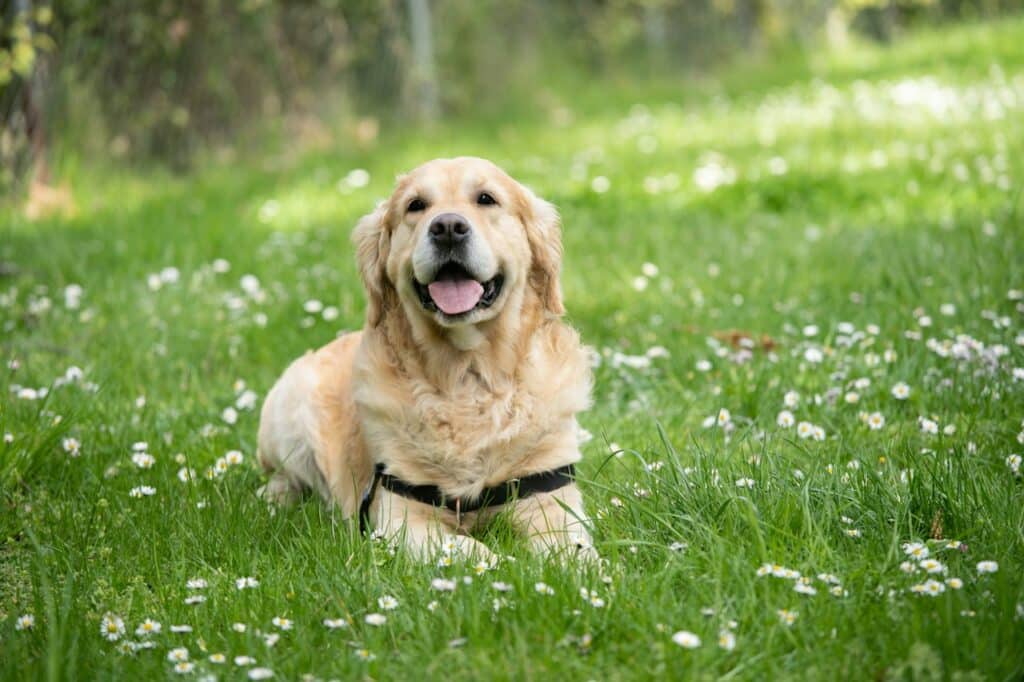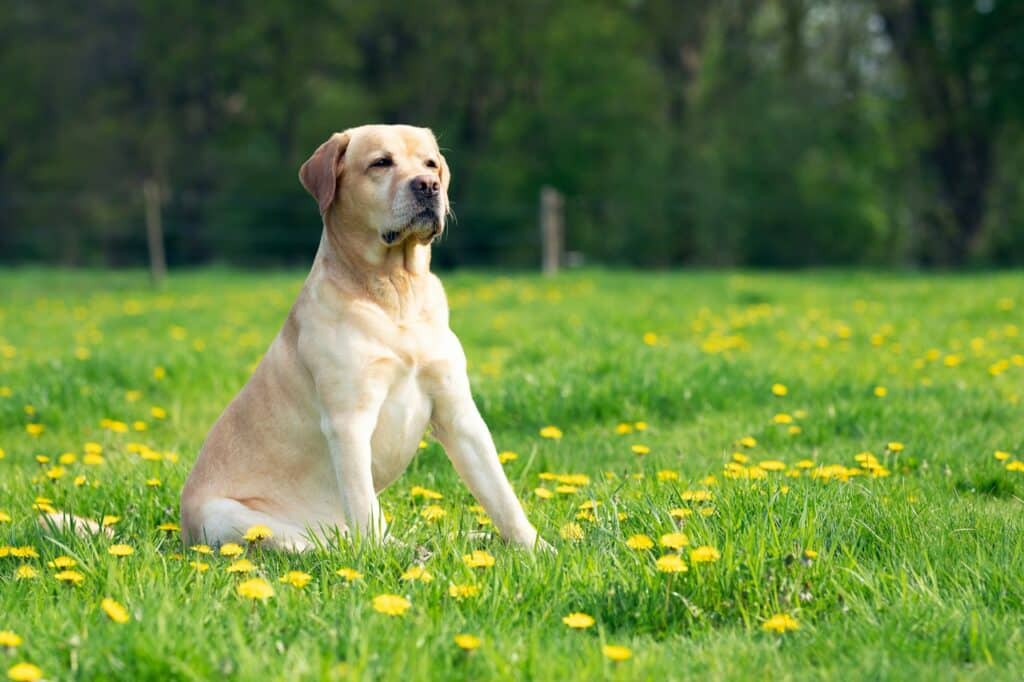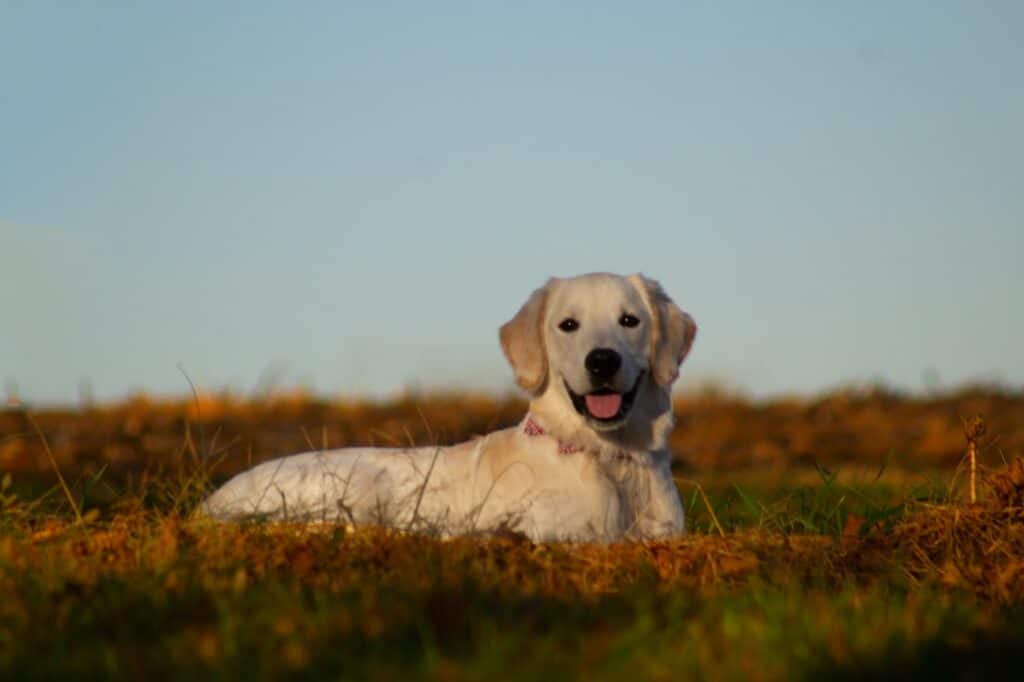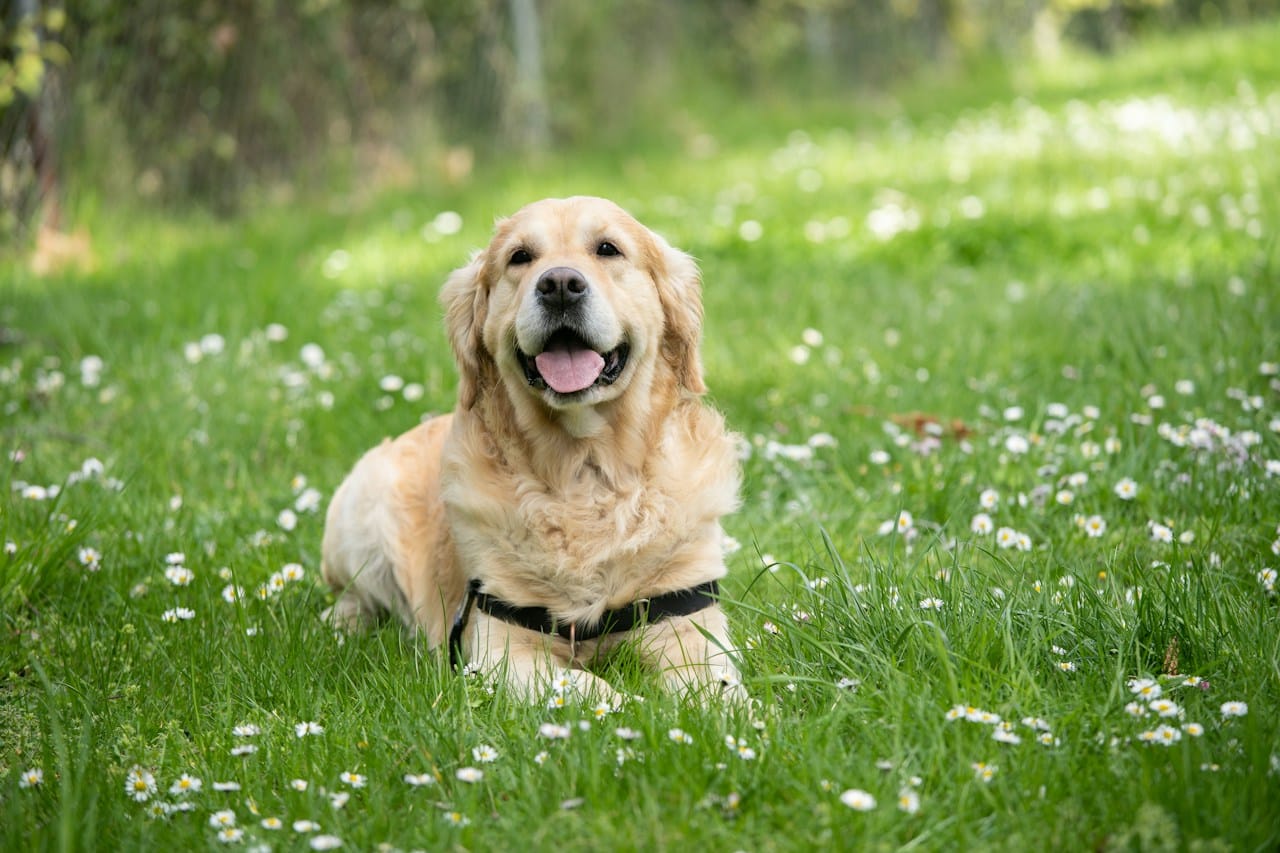The Labrador Retriever is a joyful and active dog that German families love for being friendly and trustworthy. Let’s discover some cool things about this popular dog.

Table of Contents
History of the Labrador Retriever:
Labrador Retrievers come from Newfoundland Island in Canada. Back in the late 15th century, settlers brought working dogs that turned into various Canadian water dog breeds, including the St. Johns Dog, the ancestor of today’s Labradors.
You might be interested in : Can dogs eat sausage? Is sausage bad for dogs?
Evolution of the Breed: From St. Johns Dog to Modern Labrador:
St. Johns Dogs were known for their water-resistant fur and ability to work in icy waters, helping fishermen with tasks like pulling nets and retrieving fish.
In the early 19th century, some St. Johns Dogs made their way to England. Nobles, like the Earl of Malmesbury, saw their talent in waterfowl hunting and started breeding them.
The Emergence of the “Labrador Retriever”:
Around 1870, the name “Labrador Retriever” became common in England. Influential people like the Earl of Malmesbury and the Dukes of Buccleuch played a role in shaping the breed.
Labradors were bred to find and bring back hunted game. Dogs good at fetching were wanted, and they were trained for a “soft mouth” to bring back prey undamaged.
Today’s Labradors have roots in these English hunting dogs. After 1930, their popularity expanded beyond hunting, and two lines emerged: the slim Field Trial line for hunting and the robust Show line for exhibitions and family companionship.
In the mid-20th century, English Labs focused on appearance, and American Labs specialized in field trials and work tasks.
The Labrador Retriever, recognized by the FCI, is a versatile and beloved dog breed classified in the first section of the eighth FCI group

Differences Between English and American Labrador Retrievers
Appearance
– English Labs are stockier with a broader head and shorter snout.
– American Labs are slimmer with longer snouts.
Size and Weight
– English Labs are smaller but heavier and more robust.
– American Labs are larger, leaner, and have a more athletic build.
Temperament:
– American Labs are considered more active and energetic, ideal for fieldwork and sports.
– English Labs are often calmer and more relaxed, making them popular family dogs.
Labrador Appearance:
Labradors are medium to large dogs with a sturdy body. They weigh between 23 and 36 kg. Their body is well-proportioned, with a healthy balance between leg length and spine length, often described as “short-coupled.”
They have a broad skull with chiseled features, a friendly expression, and soft ears. Their body ends in a thick tail tapering to a point. The complete muzzle houses an efficient cooling system and a strong jaw with 42 large white teeth.
Read Also: Can dogs eat pickles? Are pickles bad for dogs?
Coat and Color Variations:
Labradors have a shiny, oily coat with straight hairs, dense undercoat, and a water-resistant topcoat to keep them warm in the coldest waters.
Standard Colors:
– Black: Solid black coat, often shiny and smooth, with a black nose and dark brown eyes.
– Yellow: Shades range from light cream to dark fox red, with dark brown or hazel eyes and a black or brown nose, depending on the fur color.
– Chocolate: Deep, rich brown ranging from medium to dark chocolate, with dark brown eyes and a brown nose.
Non-Standard Colors:
– Silver: Ranges from light silver to dark slate gray.
– Charcoal: Dark gray coat, similar to a black Labrador with a lighter shade.
– Champagne: A pale, cream-colored coat resembling a very light yellow Labrador.
– Fox Red: A deeper, reddish-brown fur color, a variant of yellow Labradors.

Breed Standard Compliance
Making sure Labradors follow certain rules helps keep them healthy, especially concerning their size and body shape. There are two types of Labradors: those shown in competitions and those used for work. The differences in their physical features can affect what it’s like to own them.
What’s crucial to know is that Labradors, no matter their fur color, are affectionate, kind, smart, and dependable dogs. They want to make their owners happy. Even though some traits might be connected to how they behave, what shapes a Labrador’s personality is how they are trained and the environment they’re in, not the color of their fur.
Traits and Characteristics
The Labrador Retriever is a friendly and smart dog with a strong willingness to work, rarely seen as dangerous. It stays calm in various situations and is always open and gentle. It meets strangers and other dogs without aggression, making it less suitable as a guard dog.
Labs are very trainable, even for beginners. Some dogs even have a strong “will to please,” meaning they want to make their owners happy. They are intelligent and learn new commands and games with great enthusiasm.
This sporty dog loves long walks in any weather, making it perfect for active families who enjoy outdoor activities. Labs are people-oriented and feel happiest in a family with lots of social interaction.

How to Care for a Labrador Retriever?
Before getting a Labrador puppy, be aware of the responsibility it comes with. While they are easy to train compared to other breeds, Labs have high demands on their owners. Make sure you can commit to a dog for a long time, as Labradors have a lifespan of 10-14 years. Daily walks and avoiding leaving the dog alone for too long are essential.
Due to their strong bond with their owners, Labs are not suited for kennel living and don’t enjoy being alone at home.
Pros and Cons of Labrador Retrievers
Labradors are known for their friendly and sociable nature. They make wonderful family dogs and get along well with children and other pets. As water dogs, they love swimming, aided by their webbed toes for efficient movement in water.
Labradors can be very energetic and need a lot of exercise. Without enough physical activity, they may develop destructive behavior. They also tend to gain weight if overfed.
Read Also: Can dogs Eat Bananas?Are Bananas safe for Dogs?
All About Labrador Puppies
The price for a Labrador puppy varies based on factors like purity, age, and whether it’s a puppy or an adult. A purebred puppy from a breeder can cost between €1200 and €2000. Why are Labradors expensive?
Responsible breeders invest a lot to maintain the health and purity of the breed. You can choose from three coat colors: Chocolate Brown, Black, and Yellow, with brown Retrievers being the most expensive. If you don’t want to buy a puppy, check the “Retrievers in Need” association, where experienced people are needed to adopt Labradors from poor conditions.

Labrador Puppy Training and Development
When you pick up your Labrador puppy from the breeder, it’s usually 8-12 weeks old. Despite being small and cute, start training them early because they’ll grow into a big, strong dogs. Labradors test boundaries and need proper training to avoid behavior issues. They reach physical maturity around two to two and a half years, but they achieve sexual maturity between 6 to 10 months.
Labrador Retrievers are very curious and learn quickly but also respond fast to inconsistency. It takes effort to train them not to enthusiastically greet every person and dog. Some people and other dog breeds may have a problem with their exuberant and overly friendly nature.
Training Techniques and Challenges
Early Development Stages (8-10 Weeks):
- “Follow Me”: Encourage the puppy to follow and stay close outside.
- Recall: Intensive training, including using a whistle.
- Socialization: Almost daily outings and visits to friends and family.
- Bite Inhibition: Discourage hard biting but allow gentle chewing.
- Food Work: Teach the puppy to take food.
Development at 3-4 Months:
- Walk Beside Me: Introduce clicker training for walking by your side.
- Continued Socialization: Regular visits to busy public places.
- Retrieving: Encourage the hunting instinct.
- Touch with the Nose: Teach the puppy to touch your hand with its nose.
Behavior and Socialization:
4-5 Months: Start serious training, introduce the leash, ongoing recall training, attend events, and introduce basic commands like “Sit,” “Stand,” and “Down.”
5-6 Months and Beyond: Increase overall obedience, introduce distractions, and start advanced training.

Advanced Training and Activities
- Competition Sports: For example, Dock Diving, where dogs jump into the water to retrieve a toy—ideal for Labradors’ love of water.
- AKC Rally: A combination of obedience and agility, perfect for intelligent and eager Labradors.
- Competitive Obedience: Demonstrates the dog’s discipline through a series of commands and exercises.
- Hunting Training: Especially for waterfowl hunting, utilizes instincts and a love for water.
- Scent Work: A fascinating and rewarding training that engages the dog’s instincts, stimulating the mind and body.
Adapting to Different Lifestyles
Labradors can adapt to various living situations, such as apartments or houses with gardens. Training can make this adaptation easier.
Read Also: Can you give dogs aspirin?
Activities with the Labrador Retriever
A Labrador Retriever is very energetic and needs a lot of exercise, both physically and mentally. This active dog requires several hours of daily physical activities and mental exercises. Daily long walks and diverse training should be part of your routine. Since Labradors were bred for retrieving, they love fetching sticks or playing ball with enthusiasm.
They especially enjoy retrieving things from the water and swimming a few laps. If you want to use daily fetching as training, try professional dummy training. The breed is suitable for short, intense movement games that enhance their agility and intelligence. Of course, you can also take them hiking or jogging.
Labradors as Hunting Dogs
Labradors were bred as hunting dogs, especially for waterfowl hunting. Their dense, water-resistant fur and webbed toes make them excellent swimmers. They also have a “soft mouth,” meaning they can pick up the game without damaging it. Many Labradors today are still active hunting dogs, while others work in search and rescue, drug detection, and as guide dogs for the blind.
The Labrador Retriever Loves to Retrieve
It’s essential to keep the intelligent dog engaged with exciting intelligence and skill games, where they can earn treats. You can find a variety of intelligence toys in pet stores, or you can make them yourself. These games require thinking, and Labradors use their keen sense of smell to open drawers, operate levers, or lift cones to get a treat.
Health and Inherited Diseases
Joint Problems
Labradors often suffer from joint problems like elbow and hip dysplasia. These conditions affect normal joint movements, leading to pain and immobility. While dysplasia is not avoidable, its effects can be reduced by maintaining a healthy weight, providing high-quality nutrition, and incorporating appropriate joint-friendly exercises (swimming is ideal).
Overweight and Obesity
Obesity is a common issue in Labradors. To prevent it, monitor feeding habits to avoid excessive or too rapid eating.
Ear Infections
Labradors with their large, floppy ears are prone to ear infections. Regular cleaning and drying of the ears, especially after swimming, along with removing excess hair, can help prevent ear infections.
Heart Diseases
Heart diseases are a common problem in the canine community. Regular vaccinations, high-quality nutrition, hydration, and exercise are crucial for prevention.
Genetic Predispositions
Labradors are prone to several genetic issues, especially hip and elbow dysplasia, and eye conditions like progressive retinal atrophy (PRA), which can lead to blindness. Other concerns include Exercise-Induced Collapse (EIC), a neuromuscular disorder, and Centronuclear Myopathy (CNM), causing muscle atrophy.

Preventive Health Measures
Nutrition and Lifestyle
A healthy diet and regular exercise are crucial to prevent problems like obesity and associated health issues such as joint problems, diabetes, and heart diseases.
Diagnosis and Treatment of Dysplasias
Hip and elbow dysplasias are often diagnosed through a combination of physical examination, X-rays, and other diagnostic tests. Treatment can vary depending on severity, ranging from rest and modifications in movement to pain management medications. In severe cases, surgery may be necessary.
Regular Check-ups
Regular check-ups and a balanced diet can help prevent or manage these health problems.
Average Lifespan of Labradors
The Labrador Retriever, known for its friendly nature, has an impressive average lifespan of 10 to 14 years. This longevity is due to its robust genetics originating from Newfoundland. Both English and American Labradors benefit from this robust health.
A balanced diet and regular exercise, supported by their webbed toes, contribute to the health of Labradors. Despite their high life expectancy, regular veterinary visits are essential to detect potential health issues early.
Specific Health Tests
Recommended health tests for Labradors, such as hip evaluation, eye tests, and genetic screening for inherited conditions, are crucial for potential Labrador owners or breeders.
Caring for a Labrador
Grooming
Labradors are known for their low-maintenance, short coat. Regular brushing is necessary to remove loose hair, especially during their biannual shedding. Their dense, weather-resistant coat should never be cut or trimmed. Daily brushing during shedding helps remove dead hair.
Bathing and Shampoo
Labradors should be bathed, especially after swimming in pools, to remove chlorine that can dry out their coat. Use high-quality dog shampoo and rinse with clean, warm water.
Nail Care
A Labrador’s nails should be trimmed to maintain healthy, well-arched toes. When you hear the nails clicking on the floor, it’s time for a trim. We recommend doing this approximately every three to four weeks.
Dental Care
Regular dental care is essential. Veterinarians recommend brushing your Labrador’s teeth daily with a special dog toothbrush and toothpaste. Professional dental cleanings may be necessary, so discuss this with your vet.
Ear and Eye Care
A Labrador’s ears should be checked for excessive wax buildup and cleaned to prevent infections. Also, clean their eyes with a clean cloth after outdoor play or swimming.
Flea and Tick Protection
The Labrador’s dense double coat provides ideal hiding spots for fleas and ticks. Regular combing and monthly baths help discover and remove these pests before they can cause issues.
Labrador Retriever as Everyday Helpers
Labradors are helpful in many ways. They make great friends for people who need assistance, like those with disabilities or who are blind. Labradors are also excellent therapy dogs, bringing comfort to kids and older folks.
Their love for people and clever minds also makes them valuable in rescue teams, especially in water or avalanches. Labradors are especially good at detecting low blood sugar and are often chosen as diabetic-alert dogs.
Armstrong, the first dog known for sensing low blood sugar, set a record in the Guinness Book of World Records in 2015. Labradors are used around the world in police and military work because of their skills and intelligence.

Interesting Facts about the Labrador Retriever
The Labrador is globally popular and has been featured in many TV shows and movies. The film “Marley & Me” with Owen Wilson and Jennifer Aniston gained particular attention.
In the movie, they get a yellow Labrador named Marley, who creates chaos but becomes a beloved family member. Some celebrities like Gwyneth Paltrow, Anne Hathaway, and Prince Charles are true Labrador fans. During Bill Clinton’s presidency, he had a brown Labrador Retriever named Buddy as the First Dog.
The Labrador is considered one of the most loyal dog breeds. The Labrador-Boxer mix named Jimpa holds the record for the longest distance traveled by a dog. She covered 3,218 kilometers to find her way back home to Pimpinio, Australia. Another record was set at the largest purebred dog walk in Warsaw, where 700 Labradors participated.


